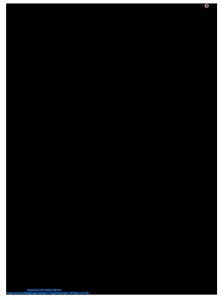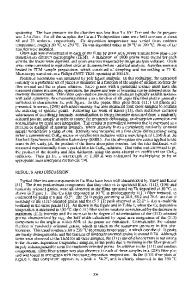Multiple Layers of Copper Thin Films of Alternating Textures
- PDF / 2,759,981 Bytes
- 5 Pages / 612 x 792 pts (letter) Page_size
- 42 Downloads / 367 Views
Multiple Layers of Copper Thin Films of Alternating Textures Hanchen Huang*, Department of Mechanical, Aerospace and Nuclear Engineering, Rensselaer Polytechnic Institute, Troy, NY 12180; H. L. Wei, H. Y. Liang, and C. H. Woo, Department of Mechanical Engineering, Hong Kong Polytechnic University, Hong Kong; X. X. Zhang; Department of Physics, Hong Kong University of Science and Technology, Hong Kong ABSTRACT In this paper, we present a preliminary study of texture development during copper thin film deposition. Using direct current (DC) magnetron sputtering technique, we deposit copper films on a SiO2/Si(111) substrate. A thin layer of copper of texture first develops, and another thin layer of ensues. As deposition continues, a third layer of copper of texture forms on the top, leading to a copper thin film of alternating and textures. The multiple layers of copper thin films of alternating textures form during continuous deposition without changing deposition conditions. The film morphology is characterized with scanning electron microscopy (SEM) and atomic force microscopy (AFM), and the texture with X-ray diffraction (XRD). Based on anisotropic elastic analyses and molecular dynamics simulations, we propose a model of texture evolution during the formation of multilayers, attributing the texture evolution to the competition of surface and strain energies. INTRODUCTION Multilayers are commonly used in electronic and magnetic applications [1,2]. In these multilayers, at least two components of materials are involved. The advantages of these multilayers are well demonstrated by their widespread applications. It would be even better if the thickness of each layer can be changed after deposition – this may prove to be particularly advantageous for space applications. One possibility may be realized through the deposition of thin films of single component materials – each layer having a unique texture. The thickness of each layer of given texture can be altered through texture competition. Over the past years, we have been studying the texture competition by combining computer simulations [3] and experiments [4]. Recently, we have shown that texture develops from a film/substrate of predominantly texture during the deposition of copper thin films. In essence, the copper film deposited was a bi-layer – one layer being in texture and another . Simple elastic analyses indicate that it would be possible for the texture to dominate again, if the deposition continues. In the following, we present the experimental realization of the return of the texture, and thereby the formation of a copper film of multilayers with alternating and textures; interpretation of the experimental results is facilitated by accompanying molecular dynamics simulations. EXPERIMENTS The copper film is deposited using direct current (DC) magnetron sputtering technique. The experimental conditions are briefly summarized as the following. The sputtering power is 100W, and the chamber is filled with 99.999% Ar, flowing into the chamber at a rate of 8.5
Data Loading...











